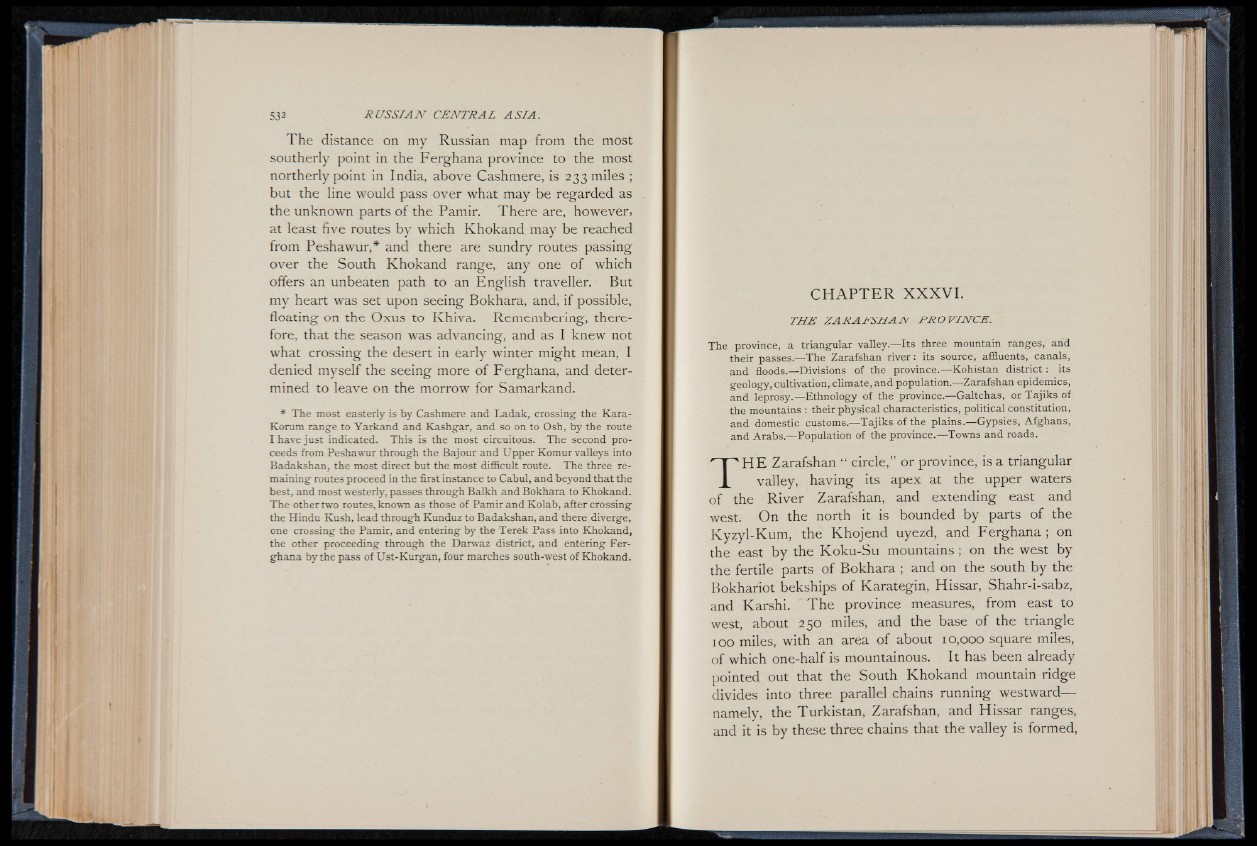
The distance on my Russian map from the most
southerly point in the Ferghana province to the most
northerly point in India, above Cashmere, is 233 miles ;
but the line would pass over what may be regarded as
the unknown parts of the Pamir. There are, however,
at least five routes by which Khokand may be reached
from Peshawur,* and there are sundry routes passing
over the South Khokand range, any one of which
offers an unbeaten path to an English traveller. But
my heart was set upon seeing Bokhara, and, if possible,
floating on the Oxus to Khiva. Remembering, therefore,
that the season was advancing, and as I knew not
what crossing the desert in early winter might mean, I
denied myself the seeing more of Ferghana, and determined
to leave on the morrow for Samarkand.
* The most easterly is by Cashmere and Ladak, crossing the Kara-
Korum range to Yarkand and Kashgar, and so on to Osh, by the route
I have ju s t indicated. This is the most circuitous. The second proceeds
from Peshawur through the Bajour and Upper Komur valleys into
Badakshan, the most direct but the most difficult route. The three remaining
routes proceed in the first instance to Cabul, and beyond that the
best, and most westerly, passes through B alkh and Bokhara to Khokand.
The other two routes, known as those of Pamir and Kolab, after crossing
the Hindu Kush, lead through Kunduz to B adakshan, and there diverge,
one crossing the Pamir, and entering by the Terek Pass into Khokand,
the other proceeding through the Darwaz district, and entering Ferghana
by the pass of Ust-Kurgan, four marches south-west o f Khokand.
C H A P T E R X X X V I .
TH E Z A R A F S H A N P R O V IN C E .
The province, a triangular valley.— Its three mountain ranges, and
their passes.— The Zarafshan river: its source, affluents, canals,
and floods.— Divisions of the province.— Kohistan d is tr ic t: its
geology, cultivation, climate, and population.—-Zarafshan epidemics,
and leprosy.— Ethnology of the province.— Galtchas, or T ajik s of
the mountains : their physical characteristics, political constitution,
and domestic customs.— T ajik s of the plains.— Gypsies, Afghans,
and Arabs.— Population of the province.— Towns and roads.
TH E Zarafshan “ circle,” or province, is a triangular
valley, having its apex at the upper waters
of the River Zarafshan, and extending east and
west. On the north it is bounded by parts of the
Kyzyl-Kum, the Khojend uyezd, and Ferghana ; on
the east by the Koku-Su mountains; on the west by
the fertile parts of Bokhara ; and on the south by the
Bokhariot bekships of Karategin, Hissar, Shahr-i-sabz,
and Karshi. The province measures, from east to
west, about 250 miles, and the base of the triangle
100 miles, with an area of about 10,000 square miles,
of which one-half is mountainous. It has been already
pointed out that the South Khokand mountain ridge
divides into three parallel chains running westward—
namely, the Turkistan, Zarafshan, and Hissar ranges,
and it is by these three chains that the valley is formed,